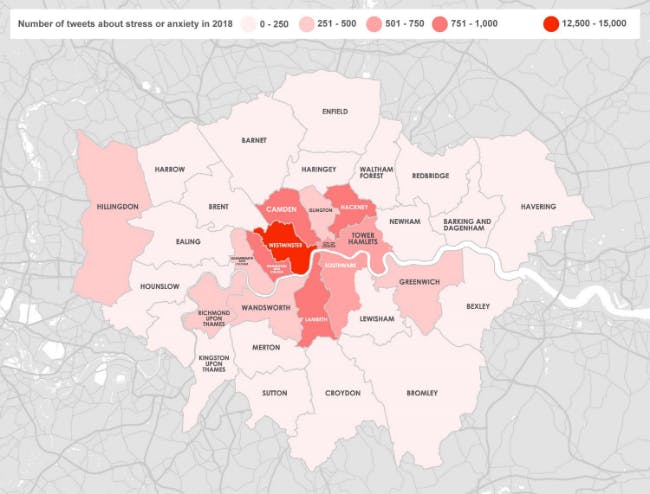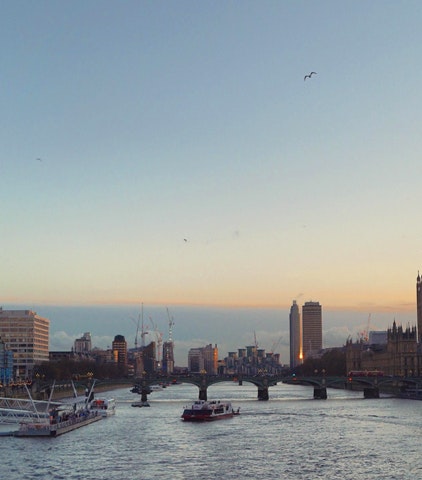
New research reveals the most stressful London borough to work in
Stress, depression and anxiety has been a topic of debate in the UK in recent years, and with over 526,000 workers suffered from work-related stress, depression or anxiety in the UK alone, it’s easy to see why!
The government’s Health and Safety Executive (HSE) website reported that 526,000 workers suffered from work-related stress, depression or anxiety between 2016/2017 - with leave, absences and sick days leading to a loss of 12.5 million business working days.
According to a survey published by The Telegraph, a whopping 59% of those working in London said they suffer from workplace stress and/or anxiety. But if we were to delve into this even further, breaking this down by borough – which area of London would have the highest rate of workplace stress?
Here at SpaSeekers.com, we gathered data from social media to find out which areas of the capital are suffering the most when it comes to mental health. We analysed a total of 24,000 mentions of the words ‘stress’ and ‘anxiety’ across London from January through to September 2018.
Mapping out the stress

Based on mentions of stress and anxiety across various social media platforms, we found that the top 20 most stressful boroughs of London to work in, are as follows:
London borough Mentions of stress and anxiety*
| Westminster | 12,808 |
| Hackney | 874 |
| Camden | 868 |
| Lambeth | 804 |
| Kensington and Chelsea | 796 |
| Southwark | 553 |
| City of London | 540 |
| Tower Hamlets | 515 |
| Hillingdon | 462 |
| Hammersmith and Fulham | 431 |
| Richmond upon Thames | 429 |
| Islington | 412 |
| Wandsworth | 356 |
| Bromley | 286 |
| Greenwich | 282 |
| Croydon | 249 |
| Kingston upon Thames | 248 |
| Hounslow | 225 |
| Redbridge | 217 |
| Newham | 206 |
The borough of Westminster topped the list as the most stressed-out area of London, with 12,808 mentions of stress and anxiety across social media channels. Home to the Palace of Westminster, the central borough is the workplace for many government workers, which may have been a prime contributor to the higher levels of stress recorded in the area.
However, even trendy neighbourhoods such as Hackney and Camden, which are known for being creative, artsy and cutting edge, also appear at the top of the list.
Results show that those working in Hackney totalled 874 mentions of stress and anxiety since the new year began, while Camden was close behind with 868. Hipster-friendly Lambeth came in fourth, with 804 mentions.
The heatmap above demonstrates that the most central areas of London are the ones that tend to have higher levels of stress, except for Hillingdon further out in West London, which lands at ninth on the list with 462 stress-related social media mentions.
At the other end of the scale, Barking and Dagenham came out as the least stressed borough with a mere 34 mentions of our tracked hashtags put it in 33rd place.
Mental health in the workplace
According to the HSE, people with careers in public administration and defence were found to have higher than average stress levels, with over 2,000 reported cases per 100,000 employees.
A report published in The Telegraph highlighted the most common causes of work-related stress. The stressors included, but were not limited to; customer and client satisfaction, office politics and working long hours. Individuals earning more than £40k per annum were also found more likely to suffer from mental health issues as a result of their jobs.
These days employers are under more pressure than ever to create a comfortable, supportive and stress-free working environment for their employees. There is even a nationwide campaign underway to force all employers to have a designated mental health first aider within the workplace, led by Leeds-based solicitor and Managing Director of Thrive Law, Jodie Hill.
“We have physical first aiders in the workplace, and yet mental health issues occur more often and cost more to businesses,” said Jodie Hill, in an interview with The Yorkshire Post. “The law is outdated in this area and needs reform.
“The mental health first aider course only takes two days and costs a few hundred pounds. The insight businesses will get into mental health problems and how to effectively manage these will be invaluable.”
How to reduce workplace stress
It goes without saying that all working environments can become stressful at one time or another and whilst it is up to employers to create the right working environment for their staff members, there are a few simple ways in which we can help to reduce workplace stress ourselves. Here are some of our top tips to help you achieve a more productive, stress-free environment at work.
Get your day off to a good start
A chaotic morning is only going to pave the way for more even chaos throughout the day. So getting the day off to a good start is key!
Preparing for your working day the evening before can be a great way to help you to feel more organised and in control. Tasks such as preparing lunches or laying out your clothes ready for the day ahead, can help to shave valuable time off of your morning routine and make you feel more at ease. Getting a good night’s sleep can also drastically improve your mood and level of productivity.
Manage your expectations
Once at work, make a list of the tasks which you need to complete for the day. Make sure that you have a clear understanding of those tasks and have everything you need in order to complete them. If in doubt, ask for your help.
Clarify the requirements expected of you and plan your day ahead. Some tasks may take longer than others or you may face unexpected obstacles. Allow yourself sufficient time to complete each task and be realistic with your expectations.
Create a comfortable working environment
It goes without saying that a disruptive, noisy and uncomfortable working environment may not be the ideal environment for creating great work and being productive. Whilst we cannot always change our working environment, we can find ways to become more comfortable whilst at work. If you are struggling to concentrate, why not find a quieter, more isolated space to work in? If your employer has a flexible working policy, then why not take advantage? You’d be surprised at how much extra work you can get done by switching up your workspace. Taking regular breaks away from screens and paperwork can really help you to recharge and may help productivity by coming back to a task with a new outlook.
Take regular breaks
Being cooped up in an office all day is enough to drive anyone crazy. Why not try taking a walk or squeeze in some workplace exercise? Taking a moment to yourself to just simply get outside and get a bit of fresh air can help to revitalise your mindset and leave you feeling ready to take on the rest of the day!
These are just a few examples of how to reduce workplace stress, but there is still so much that both employers and employees can do to combat workplace stress.





